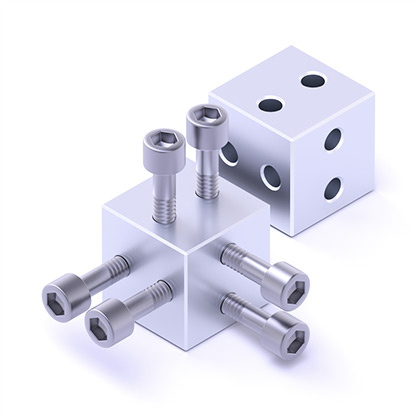3D Construction Set for the 3D Printing Age
Desktop 3D printing has revolutionized the production of custom parts. Unfortunately, low-cost 3D printers are only useful for a narrow range of part dimensions.
Small, thick, and blocky prints usually come out well. They are strong and reasonably precise. Long and thin parts shrink, warp, and withstand no useful load.
Enters UNI•QB, our innovative 3D construction set for the 3D printing age.
Remember the construction sets of yesteryear? You probably had one as a kid. It contained stamped rounded sticks with holes in them. You could make just about anything with these sticks, as long as it was a toy.
UNI•QB is a 3D construction set for industrial and lab applications requiring strength and precision. The kit includes innovative, patent-pending solid cubes and beams that are CNC-machined or molded from a high-grade metal alloy.
With UNI•QB, you can assemble the skeletal structure of your creation from our beams and cubes, then design and print your small custom parts on your desktop printer. This is quick, inexpensive, and the resulting structure is exceptionally robust.
As with many inventions, UNI•QB was born of necessity. Tibbo needed a way to speed up the creation of manufacturing fixtures and props, and I just couldn’t seem to find the right way of building them fast and cheap. I had a 3D printer, but it was useless for most of my tasks… until I invented the UNI•QB kit, that is.
Now all our robotic fixtures, like the one shown on the right, are made with this new approach. We assemble the bulk of our manufacturing props from beams and cubes of the kit, then add specialized parts fabricated on a low-cost desktop 3D printer.
I hope my new UNI•QB kit will get your creative juices flowing. What will you build with it? Let me know at www.uniqb.com/myidea.
Dmitry Slepov
Managing Director and Co-founder,
Tibbo Technology Inc.













